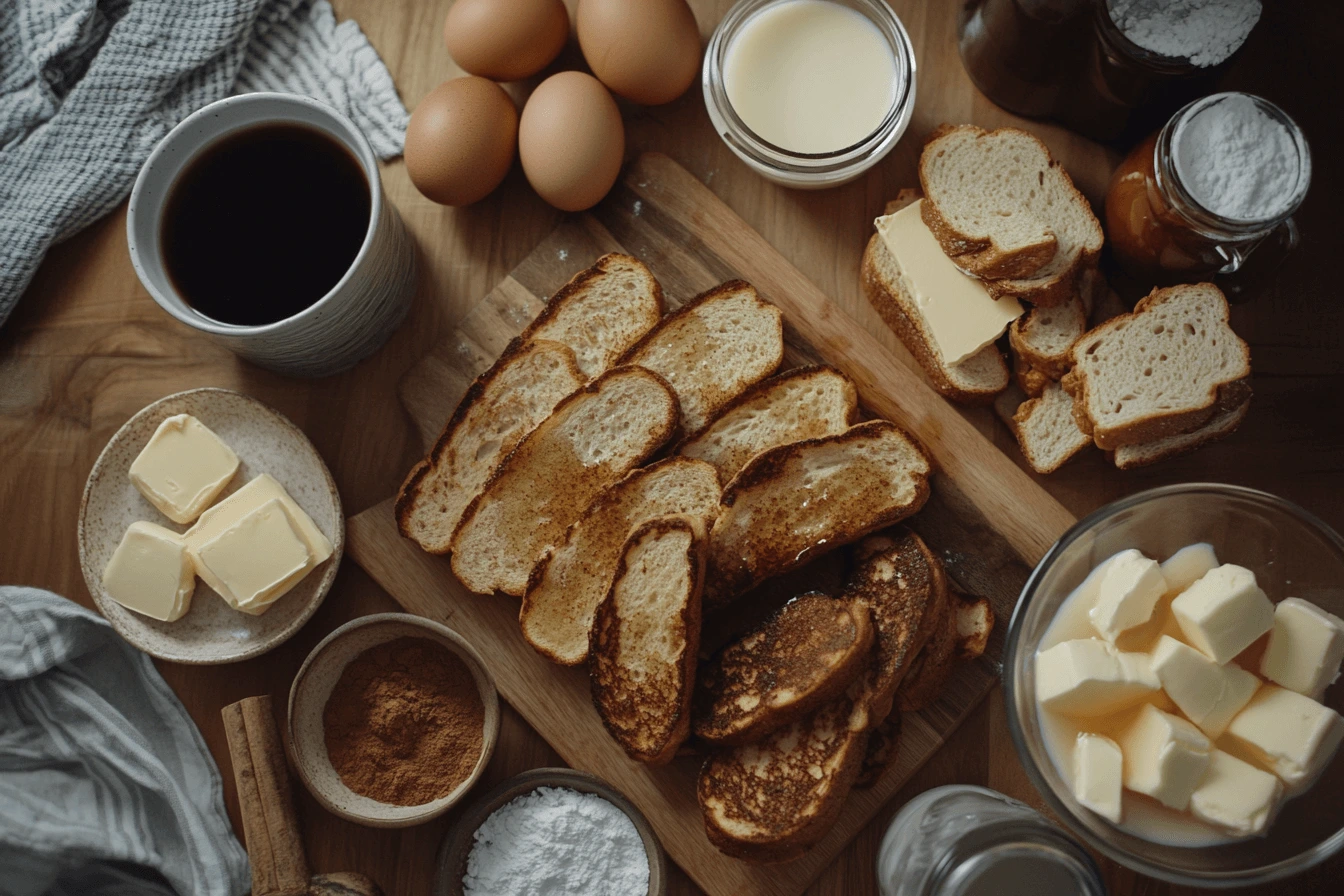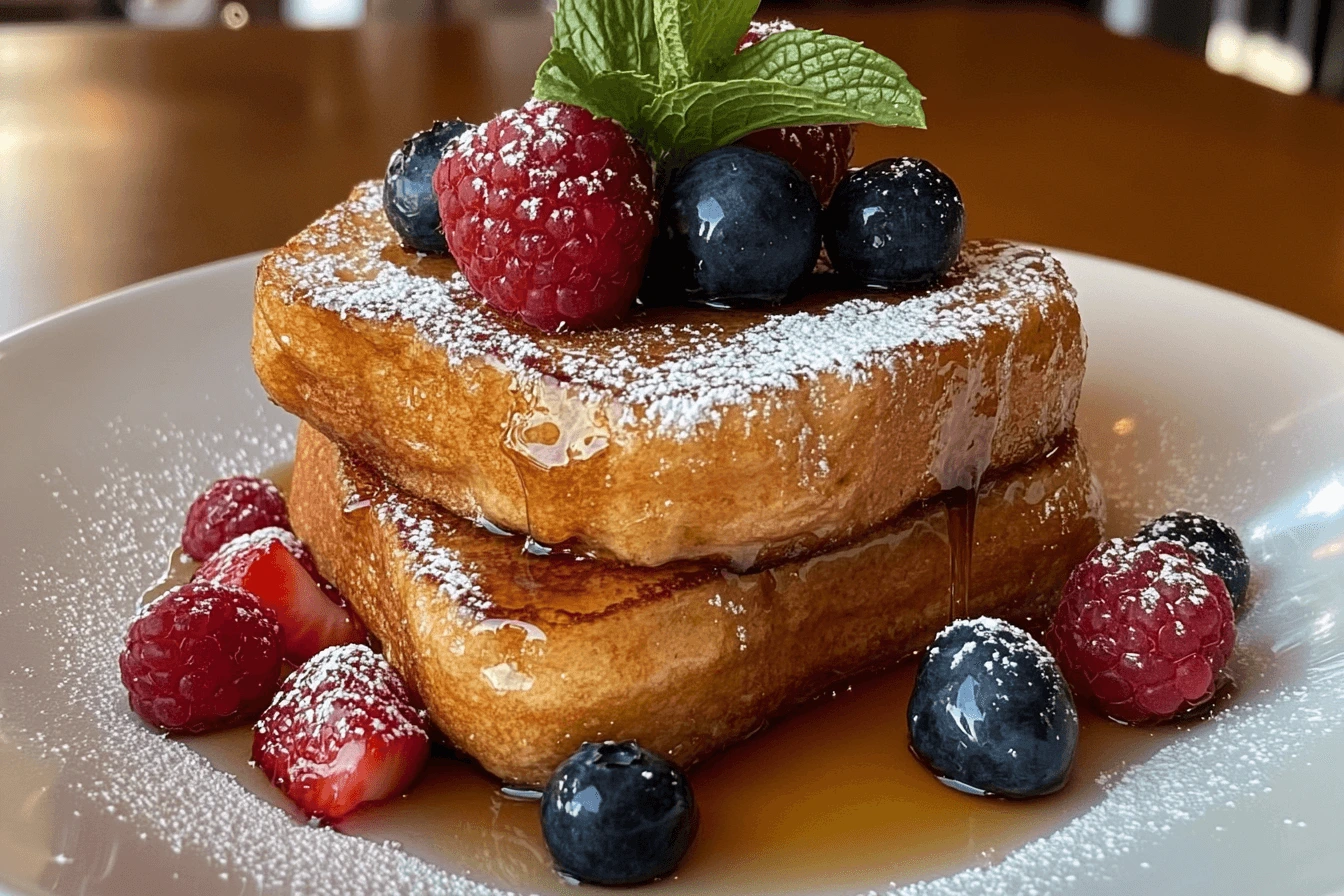French toast is a breakfast favorite, but have you ever tried it with sourdough bread? If not, you’re in for a treat! Sourdough French toast is the perfect combination of crispy edges, a soft and fluffy center, and a deliciously tangy flavor. It takes your classic French toast recipe to the next level, making every bite extra special.
In this guide, we’ll cover everything you need to know about making the perfect sourdough French toast, from choosing the right ingredients to mastering the best cooking methods. Whether you’re a beginner or an experienced cook, this article will help you create a restaurant-quality breakfast right at home.
What is Sourdough French Toast?
At its core, sourdough French toast is a variation of traditional French toast, but with a unique twist. Instead of using regular white or brioche bread, we use sourdough bread, which has a more complex flavor and a chewy texture.
Sourdough is made through a natural fermentation process that gives it a slight tanginess. This tangy flavor pairs beautifully with the rich, custardy mixture used to make French toast, resulting in a dish that is both savory and slightly sweet.
Why Use Sourdough for French Toast?
Using sourdough bread for French toast is more than just a delicious choice—it also brings unique benefits that enhance the dish’s flavor, texture, and even health benefits. Let’s explore why sourdough is the perfect bread for making the ultimate French toast.
1. Flavor Benefits
Sourdough bread has a distinctive tangy taste, thanks to the natural fermentation process it undergoes. This mild sourness contrasts beautifully with the sweet elements of French toast, such as maple syrup, cinnamon, and vanilla. The result? A more complex, rich flavor profile that makes each bite more enjoyable.
Unlike plain white bread, which can taste bland on its own, sourdough adds depth to your French toast, making it taste more gourmet without requiring extra ingredients.
2. Texture Advantages
One of the biggest challenges when making French toast is achieving the perfect texture—crispy on the outside and soft on the inside. Sourdough bread naturally has a sturdy structure and a chewy crumb, which means it holds up better when soaked in the egg mixture.
Other softer breads, like brioche or sandwich bread, tend to absorb too much liquid, which can make the French toast soggy. In contrast, sourdough absorbs just the right amount of custard while maintaining its structure, giving you crispy edges and a fluffy, slightly chewy center.
3. Health Benefits
Sourdough bread isn’t just tasty—it’s also one of the healthiest bread options. Here’s why:
- Easier to Digest: The fermentation process breaks down gluten, making sourdough easier to digest compared to regular bread.
- Lower Glycemic Index: Sourdough causes a slower rise in blood sugar levels, making it a better choice for those watching their sugar intake.
- Rich in Nutrients: It contains beneficial bacteria, which support gut health, and is a good source of vitamins and minerals like iron and B vitamins.
Essential Ingredients for the Perfect Sourdough French Toast
Making sourdough French toast requires a few simple ingredients, but choosing high-quality options can make a big difference in the final taste.
1. Choosing the Best Sourdough Bread
Not all sourdough breads are created equal! Here’s what to look for:
- Artisan Sourdough: Bakery or homemade sourdough with a tangy flavor and open crumb structure works best.
- Thick Slices: Aim for slices about ¾ to 1 inch thick to maintain a good balance between crispiness and fluffiness.
- Day-Old Bread: Slightly stale bread absorbs the custard mixture better without becoming too mushy.
2. Eggs and Dairy
- Eggs: These provide structure and richness. Using fresh, organic eggs enhances the flavor.
- Milk or Cream: Full-fat milk, half-and-half, or even heavy cream makes the custard richer.
- Dairy-Free Options: Almond milk, oat milk, or coconut milk can be used as substitutes.
3. Sweeteners and Spices
- Sweeteners: Maple syrup, honey, or sugar add a touch of sweetness to balance the tanginess of the bread.
- Vanilla Extract: Enhances the overall flavor and adds a warm aroma.
- Cinnamon & Nutmeg: These classic spices give the French toast a cozy, spiced flavor.
- Salt: A pinch of salt helps enhance all the flavors and keeps the dish from tasting flat.
Step-by-Step Guide to Making Sourdough French Toast
Now that we have all the ingredients ready, let’s walk through the step-by-step process of making the perfect sourdough French toast. This method ensures you get a crispy, golden-brown exterior with a soft and custardy center.
1. Preparing the Custard Mixture
The custard is what gives French toast its rich flavor and creamy texture. Follow these steps to create a well-balanced mixture:
Ingredients for Custard:
- 3 large eggs
- ¾ cup whole milk (or half-and-half for a richer taste)
- 1 tbsp maple syrup or sugar
- 1 tsp vanilla extract
- ½ tsp cinnamon
- ¼ tsp nutmeg (optional)
- A pinch of salt
Instructions:
- In a shallow dish or mixing bowl, whisk the eggs until they are well beaten.
- Add the milk (or cream), maple syrup, vanilla extract, cinnamon, nutmeg, and salt.
- Whisk everything together until the mixture is smooth and well combined.
Tip: If you want an extra smooth custard, blend the mixture using an immersion blender. This ensures even coating on the bread slices.

2. Soaking the Bread
Soaking the bread correctly is crucial for achieving the ideal texture. Here’s how to do it:
- Place your sourdough slices in the custard mixture one at a time.
- Let each slice soak for 15-20 seconds per side—just enough to absorb the mixture without becoming soggy.
- If your bread is very dense or stale, you can let it soak a little longer, but avoid oversoaking.
Tip: Use a fork or tongs to gently press the bread into the custard so it absorbs evenly.
3. Cooking Techniques for Perfect Sourdough French Toast
There are multiple ways to cook French toast, but the stovetop method is the most traditional. Let’s go over the best cooking techniques.
Stovetop Method (Best for Classic French Toast)
What You’ll Need:
- 1 tbsp butter or coconut oil
- A non-stick or cast-iron skillet
Instructions:
- Heat a skillet over medium-low heat and add butter or oil.
- Once the butter is melted, place the soaked sourdough slices onto the pan.
- Cook for 3-4 minutes per side, or until golden brown and slightly crispy.
- Transfer to a plate and repeat with remaining slices.
Tip: Cooking on medium-low heat prevents the outside from burning while allowing the inside to cook thoroughly.
Oven-Baked Method (Best for Cooking in Batches)
If you’re making French toast for a crowd, the oven method is convenient.
- Preheat the oven to 375°F (190°C) and line a baking sheet with parchment paper.
- Arrange the soaked sourdough slices on the baking sheet.
- Bake for 10 minutes, then flip and bake for another 5-7 minutes until golden and crisp.
- Serve immediately with toppings.
Tip: For an extra crispy texture, broil the toast for the last 1-2 minutes.
Air Fryer Method (Best for Extra Crispy Texture)
- Preheat your air fryer to 375°F (190°C).
- Lightly grease the air fryer basket and place the soaked bread slices inside (do not overlap).
- Air fry for 5 minutes, then flip and cook for another 3-4 minutes.
- Serve warm with your favorite toppings.
Delicious Toppings and Variations
One of the best things about sourdough French toast is how versatile it is. You can enjoy it with classic toppings, elevate it with gourmet additions, or even transform it into a savory dish. Let’s explore some delicious ways to customize your French toast!
1. Classic Toppings
If you love traditional flavors, these toppings are perfect:
- Maple Syrup – The ultimate classic for a rich, sweet finish.
- Powdered Sugar – A light dusting enhances both taste and presentation.
- Butter – Melts beautifully into the crispy edges.
- Fresh Berries – Strawberries, blueberries, raspberries, or blackberries add a refreshing balance.
- Whipped Cream – A dollop of homemade whipped cream makes it extra indulgent.
Tip: Warm your maple syrup before drizzling it over the toast for the best flavor!
2. Gourmet Additions
Want to elevate your French toast? Try these unique toppings:
- Caramelized Bananas – Sauté sliced bananas with butter and brown sugar for a rich, caramel-like flavor.
- Nut Butter & Honey – Almond butter, peanut butter, or cashew butter drizzled with honey adds a creamy texture.
- Chocolate Hazelnut Spread – A spoonful of Nutella or melted dark chocolate makes it extra decadent.
- Toasted Nuts – Walnuts, pecans, or almonds add a delicious crunch.
- Greek Yogurt & Honey – A healthier alternative to whipped cream with a touch of sweetness.
3. Savory French Toast Variations
Sourdough’s tangy flavor makes it an excellent base for savory French toast. Here are some creative ideas:
- Avocado & Poached Egg – Top with smashed avocado, a poached egg, and a sprinkle of sea salt.
- Cheese & Herbs – Add shredded cheddar, parmesan, or feta with fresh herbs like chives or basil.
- Smoked Salmon & Cream Cheese – A luxurious brunch option with capers and red onions.
- Bacon & Hot Sauce – Crispy bacon and a drizzle of hot sauce for a bold twist.
Tip: For savory versions, skip the sugar and vanilla in the custard mixture and add salt, pepper, and a pinch of garlic powder instead.
How to Make Sourdough French Toast Ahead of Time
If you’re making French toast for a crowd or want to enjoy it throughout the week, preparing it ahead of time is a great option. Here’s how to store, reheat, and freeze your sourdough French toast properly.
1. Storing Leftovers
- Refrigeration: Store cooked French toast in an airtight container for up to 3 days.
- Separation Tip: Place parchment paper between slices to prevent sticking.
2. Reheating Methods
- Oven (Best for Crispiness): Preheat to 350°F (175°C) and bake for 5-7 minutes until warm.
- Stovetop: Reheat on medium-low heat in a buttered skillet for 2-3 minutes per side.
- Air Fryer: Air fry at 350°F (175°C) for 3-5 minutes for a crispy texture.
- Microwave (Fastest but Softest): Heat for 30-45 seconds, but note that it won’t be as crispy.
Tip: If reheating in the microwave, place a damp paper towel over the toast to keep it from drying out.
3. Freezing for Later
If you want to freeze your French toast for easy breakfasts, follow these steps:
- Let the cooked French toast cool completely.
- Place slices in a single layer on a baking sheet and freeze for 1 hour (prevents sticking).
- Transfer frozen slices to a freezer-safe bag, separating layers with parchment paper.
- Store in the freezer for up to 2 months.
Reheating Frozen French Toast:
- Bake at 375°F (190°C) for 8-10 minutes.
- Air fry at 375°F (190°C) for 5 minutes.
- Microwave for 60-90 seconds (soft texture).
Pairing Sourdough French Toast with Drinks and Sides
A great breakfast isn’t just about the main dish—it’s also about what you pair it with. The right drink or side dish can complement the flavors of your sourdough French toast, making your meal even more enjoyable.
1. Best Drinks to Pair with Sourdough French Toast
Whether you prefer something hot, cold, sweet, or refreshing, these drinks pair wonderfully with French toast:
- Classic Coffee or Espresso – A strong, bold coffee balances the sweetness of French toast.
- Chai Latte – The warm spices in chai complement the cinnamon and vanilla flavors.
- Fresh Orange Juice – A bright, citrusy juice helps cut through the richness of the dish.
- Vanilla Almond Milk – A dairy-free option that adds a hint of sweetness.
- Iced Matcha Latte – A lightly sweet, earthy drink that pairs well with both sweet and savory variations.
Tip: If you love a sweet and creamy coffee, try adding a dash of cinnamon or nutmeg to your cup—it will match the flavors in your French toast!
2. Best Side Dishes
Adding a side dish can turn your French toast into a complete meal. Here are some great options:
Light and Fresh Options:
- Fresh Fruit Salad – A mix of berries, citrus, and melon adds natural sweetness.
- Greek Yogurt with Honey – A protein-packed, creamy contrast to crispy French toast.
- Apple Compote – Warm cinnamon apples add a cozy, autumn-like touch.
Savory Complements:
- Scrambled or Poached Eggs – A great way to add protein to your meal.
- Crispy Bacon or Sausage – The saltiness balances the sweetness of French toast.
- Avocado Slices – If you’re making a savory version, avocado adds creaminess and healthy fats.
Tip: If you’re serving sourdough French toast as part of a big brunch, consider offering both sweet and savory options so everyone can customize their plate.
Common Mistakes to Avoid When Making Sourdough French Toast
Even though French toast is a simple dish, small mistakes can make a big difference in texture and flavor. Here’s what to avoid to ensure perfect results every time.
1. Using the Wrong Bread
- Mistake: Using fresh, soft bread that soaks up too much liquid and becomes soggy.
- Solution: Always use day-old or slightly stale sourdough bread to help it hold its structure.
2. Over-Soaking the Bread
- Mistake: Letting the bread soak too long in the custard mixture, making it overly wet inside.
- Solution: 15-20 seconds per side is usually enough for sourdough. If it’s too fresh, let it dry out a bit before using.
3. Cooking at the Wrong Temperature
- Mistake: Cooking on high heat burns the outside while leaving the inside undercooked.
- Solution: Use medium-low heat to cook the toast evenly, ensuring a crispy outside and custardy inside.
4. Skipping the Butter or Oil in the Pan
- Mistake: Cooking in a dry pan results in a bland, unevenly cooked toast.
- Solution: Always add butter, ghee, or coconut oil to the pan before cooking.
5. Not Whisking the Custard Well Enough
- Mistake: If the eggs aren’t fully mixed, you might get uneven flavors and patches of scrambled egg on your toast.
- Solution: Whisk thoroughly, or blend for a perfectly smooth mixture.
Tip: Want crispier toast? Sprinkle a little sugar on the bread before cooking for a caramelized crust!
Healthier Alternatives for Sourdough French Toast
Love French toast but want a lighter version? Here are some ways to make it healthier:
1. Low-Sugar Options
- Swap maple syrup or sugar with stevia, monk fruit, or mashed banana in the custard.
- Use unsweetened almond milk or oat milk instead of dairy.
- Top with fresh fruit instead of sugary syrups.
2. Dairy-Free & Vegan Variations
- Milk Substitute: Use almond milk, soy milk, or coconut milk.
- Egg Substitute: Mix 1 tbsp flaxseed meal + 3 tbsp water (per egg) for a plant-based alternative.
- Butter Substitute: Cook in coconut oil or dairy-free butter.
3. High-Protein French Toast
- Add a scoop of protein powder to the custard.
- Use Greek yogurt as a topping instead of whipped cream.
- Pair with scrambled eggs or turkey bacon for extra protein

FAQs About Sourdough French Toast
Here are some of the most common questions people have when making sourdough French toast, along with expert tips to ensure the best results.
1. How do I prevent my sourdough French toast from being soggy?
- Make sure to use day-old or slightly stale sourdough bread.
- Don’t soak the bread for too long—15-20 seconds per side is enough.
- Cook on medium-low heat to allow the inside to cook through without burning the outside.
2. Can I use fresh sourdough bread instead of stale bread?
Yes, but fresh bread tends to absorb too much liquid and become soggy. To fix this, toast the bread slices lightly before soaking them in the custard.
3. What’s the best way to store leftover sourdough French toast?
- Store in an airtight container in the fridge for up to 3 days.
- Freeze individual slices with parchment paper between them for up to 2 months.
- Reheat in the oven, air fryer, or skillet for the best texture.
4. Can I make sourdough French toast gluten-free?
Yes! Use a gluten-free sourdough bread to enjoy this dish without gluten.
5. Why is my French toast not crispy?
- Make sure the pan is hot enough before adding the bread.
- Cook with butter or coconut oil for better crispiness.
- Sprinkle a little sugar on the bread before cooking to create a caramelized crust.
6. What type of pan should I use for cooking French toast?
A cast-iron skillet or non-stick pan works best for even browning and crisp edges. Avoid using pans that don’t distribute heat evenly.
Conclusion: Enjoy the Best Sourdough French Toast!
Sourdough French toast is a delicious twist on a breakfast classic, offering a perfect balance of crispy edges, fluffy centers, and a slight tang from the sourdough. Whether you prefer it sweet with maple syrup and berries or savory with avocado and eggs, this dish is incredibly versatile and easy to make.
Quick Recap for Perfect French Toast:
Use day-old sourdough bread for the best texture.
Don’t over-soak—15-20 seconds per side is ideal.
Cook on medium-low heat for even crispiness.
Pair with your favorite drinks and sides for a complete meal.
Store and reheat properly to enjoy later!

